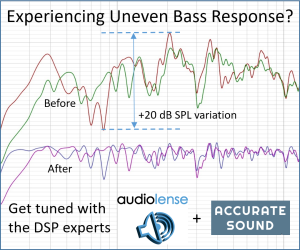Leo11
Registered
Thread Starter
- Joined
- Jul 23, 2022
- Posts
- 35
More
- Main Amp
- Hypex NC252MP
- Additional Amp
- Hypex NC502MP
- DAC
- Motu Ultralite Mk5
- Computer Audio
- Dell notebook
- Streaming Subscriptions
- Amazon Music Unlimited
- Front Speakers
- NHT C3
- Subwoofers
- 2x 12" DIY Scan Speak acoustic suspension
Hello everyone.
I have a doubt about the process of measuring and creating filters, especially in light of the latest SW releases.
If I make measurements at 96kHz, for example, and export the filter with 65K taps, I will get about 1.5Hz resolution.
While with 44kHz it should be about 0.7Hz.
Now, if I resample externally the wav file of the filter generated with 96kHz measurements to 44kHz, does its resolution change o it's always as the original (1.5hz)?
I ask this because I have my 96khz filters resampled at 44khz, and I don't know if it is appropriate to repeat the whole filter measurement and creation procedure to get the best resolution.
I have a doubt about the process of measuring and creating filters, especially in light of the latest SW releases.
If I make measurements at 96kHz, for example, and export the filter with 65K taps, I will get about 1.5Hz resolution.
While with 44kHz it should be about 0.7Hz.
Now, if I resample externally the wav file of the filter generated with 96kHz measurements to 44kHz, does its resolution change o it's always as the original (1.5hz)?
I ask this because I have my 96khz filters resampled at 44khz, and I don't know if it is appropriate to repeat the whole filter measurement and creation procedure to get the best resolution.













